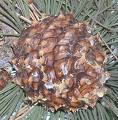Pinus Torreyana Tree Information
Images of Pinus Torreyana:






Pinus Torreyana grows in the following 1 states and provinces:
CaliforniaInformation about Pinus Torreyana:
The Pinus Torreyana is commonly known as the Del Mar Pine, Santa Rosa Island Torrey Pine, Soledad Pine as well as Torrey Pine.
The currently accepted scientific name of Torrey pine is Pinus torreyana Parry. There are no recognized varieties or forms. There are two recognized subspecies : Pinus torreyana ssp. insularis Haller Pinus torreyana ssp. torreyana.Torrey pine is the rarest pine in North America . The natural distribution of Torrey pine consists of two disjunct populations. The mainland population, in and near the Torrey Pines State Reserve (TPSR), is confined to the low coastal bluffs flanking the Soledad Valley in San Diego County, California. It consists of approximately 7,000 trees . The other population occurs on Santa Rosa Island off the coast of southern California, 175 miles (280 km) northwest of the mainland population . This population consists of approximately 2,000 trees .The Torrey pine forest is the only southern California coastal pine forest . Torrey pine part of the California closed-cone pine forests . These forests merge with coastal sage scrub, chaparral, dune scrub, and coastal salt marsh . On Santa Rosa Island, Torrey pine is a member of the Torrey pine woodland. This community ranges from a monotypic assemblage of Torrey pine with a litter understory to more open stands that resemble woodlands mixed with California scrub oak (Quercus dumosa) and shrubs . Torrey pine is listed as a codominant or dominant species in the following publications: Plant communities of Santa Rosa Island, Channel Islands National Park The closed-cone pines and cypress Preliminary descriptions of the terrestrial natural communities of California Plant communities of southern California . Some species commonly associated with Torrey pine include chamise (Adenostoma fasciculatum), California sagebrush (Artemesia californica), toyon (Heteromeles arbutifolia), lemonadeberry (Rhus integrifolia), California scrub oak, mule fat (Baccharis viminea), bush poppy (Dendromecon rigida), California encelia (Encelia californica), white sage (Salvia apiana), black sage (S. mellifera), saw-toothed goldenbush (Haplopappus squarrosus), Costa Baja manzanita (Arctostaphylos glandulosa ssp. crassifolia), Santa Rosa Island manzanita (A. confertiflora), California buckwheat (Eriogonum fasciculatum), warty-stem ceanothus (Ceanothus verrucosus), feltleaf ceanothus (C. arboreus), western yarrow (Achillea millefolium), sea fig (Carpobrotus chilensis), iceplant (Mesembryanthemum spp.), Indian paintbrush (Castilleja spp.), monkeyflower (Mimulus spp.), California poppy (Eschscholzia californica), sedge (Carex globosa), oniongrass (Melica imperfecta), bent grass (Agrostis spp.), slender wild oat (Avena barbata), and purple cudweed (Gnaphalium purpureum).Some of the information provided here is attributed to:Esser, Lora L. 1993. Pinus torreyana. In: Fire Effects Information System, [Online]. U.S. Department of Agriculture, Forest Service, Rocky Mountain Research Station, Fire Sciences Laboratory (Producer). , available at the USDA Fire Effects Information System (FEIS) website